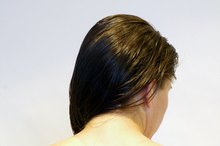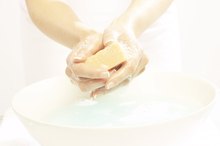Boils While Breast-feeding
Soreness and cracked skin around the nipples during breast-feeding is normal, but cracks in the skin open the way for breast infections. Developing an infection typically happens within the first six weeks of breast-feeding, though it is possible to get an infection during weaning. Infections are less common than they once were because of improved hygiene practices; if you do become infected, you may experience pain in your breasts, swelling, flu-like symptoms and boils.
If you are experiencing serious medical symptoms, seek emergency treatment immediately.
Boils
Boils are a kind of abscess. They begin as red, infected areas that become white as pus collects under your skin. Boils occur in places that are walled off so the infection cannot spread. You may see this as an engorged or swollen area on your breast, but abscesses can happen anywhere in the body, such as in your ear or appendix. Boils specifically result from germs that live on your skin.
- Boils are a kind of abscess.
- Boils specifically result from germs that live on your skin.
Antibiotics
Antibiotics for a Breast Infection
Learn More
Doctors generally prescribe antibiotics to treat the infection that cause boils. Not all antibiotics are safe for breast-feeding mothers. People with infections that affect the skin and soft tissue often use flucloxacillin. This medication is beneficial for boils, burns, wounds, ulcers and eczema. Women who are pregnant or breast-feeding should only take medications when the benefit outweighs the potential risk to their children. In the case of flucloxacillin, the amount of medication that enters a baby during breast-feeding is unlikely to harm him, according to NetDoctor 14. Consult your doctor before taking any medications
- Doctors generally prescribe antibiotics to treat the infection that cause boils.
- Women who are pregnant or breast-feeding should only take medications when the benefit outweighs the potential risk to their children.
Breast-feeding
Dr. Ketan Bharadva suggests you continue to breast-feed in the early stages of a boil. In addition to taking antibiotics, massage the area around the boil, working toward the nipple, he recommends. This prevents milk stasis, which is when milk is produced but stays in the breast. If the boil worsens, breast-feed from your other breast. He recommends you not stop breast-feeding as this can make the situation worse. Manually empty the breast that has the abscess. This helps prevent more pus from collecting in the abscessed area. Antibiotics cannot eliminate abscesses. A doctor must surgically drain the abscess. Resume breast-feeding afterward, Bharadva advises.
- Dr. Ketan Bharadva suggests you continue to breast-feed in the early stages of a boil.
- If the boil worsens, breast-feed from your other breast.
Alternative Medicine
Red Bumps on My Breasts
Learn More
Herbs may help boils. For example, slippery elm is an herbal remedy that Native Americans have used for centuries on a variety of problems, including boils, burns, skin inflammation and wounds. It may also be beneficial for sore throats, coughs and stomach problems when taken orally. There are no significant side effects from using slippery elm, according to the University of Maryland Medical Center 2. Also, slippery elm is considered safe during breast-feeding, but herbal supplements may interact with other supplements or medications. Consult your doctor before using alternative medicine.
- For example, slippery elm is an herbal remedy that Native Americans have used for centuries on a variety of problems, including boils, burns, skin inflammation and wounds.
- Also, slippery elm is considered safe during breast-feeding, but herbal supplements may interact with other supplements or medications.
Related Articles
References
- NetDoctor: Floxapen
- University of Maryland Medical Center: Slippery Elm
- Parenting and Child Health: Boils
- NetDoctor: Breast Inflammation
- Ibler KS, Kromann CB. Recurrent furunculosis - challenges and management: a review. Clin Cosmet Investig Dermatol. 2014;7:59-64. doi:10.2147/CCID.S35302
- Cleveland Clinic. Boils & carbuncles. Reviewed April 15, 2016
Writer Bio
Sarka-Jonae Miller has been a freelance writer and editor since 2003. She was a personal trainer for four years with certifications from AFAA and NASM. Miller also worked at 24 Hour Fitness, LA Fitness and as a mobile trainer. Her career in the fitness industry begin in 2000 as a martial arts, yoga and group exercise instructor. She graduated cum laude from Syracuse University.









